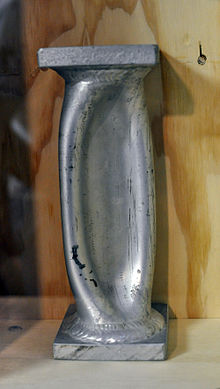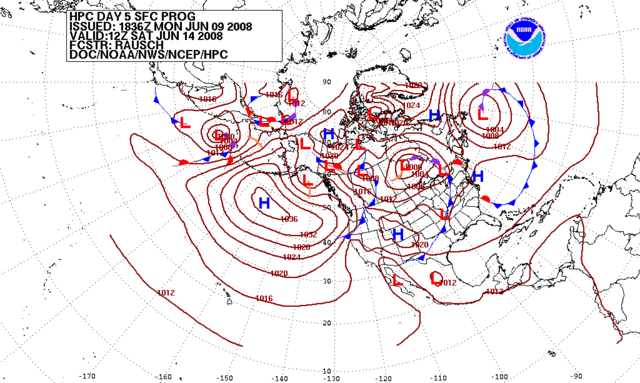Bar (unit)
Unit of pressure equal to 100,000 Pa From Wikipedia, the free encyclopedia
The bar is a metric unit of pressure defined as 100,000 Pa (100 kPa), though not part of the International System of Units (SI). A pressure of 1 bar is slightly less than the current average atmospheric pressure on Earth at sea level (approximately 1.013 bar).[1][2] By the barometric formula, 1 bar is roughly the atmospheric pressure on Earth at an altitude of 111 metres at 15 °C.
| Bar | |
|---|---|
 An aluminium cylinder of wall thickness 5 millimetres (0.20 in) after being applied with a pressure of 700 bar. | |
| General information | |
| Unit system | Metric system |
| Unit of | pressure |
| Symbol | bar |
| Conversions | |
| 1 bar in ... | ... is equal to ... |
| SI units | 100 kPa |
| CGS units | 106 Ba |
| US customary units | 14.50377 psi |
| Atmospheres | 0.986923 atm |
The bar and the millibar were introduced by the Norwegian meteorologist Vilhelm Bjerknes, who was a founder of the modern practice of weather forecasting, with the bar defined as one megadyne per square centimeter.[3]
The SI brochure, despite previously mentioning the bar,[citation needed] now omits any mention of it.[1] The bar has been legally recognised in countries of the European Union since 2004.[2] The US National Institute of Standards and Technology (NIST) deprecates its use except for "limited use in meteorology" and lists it as one of several units that "must not be introduced in fields where they are not presently used".[4] The International Astronomical Union (IAU) also lists it under "Non-SI units and symbols whose continued use is deprecated".[5]
Units derived from the bar include the megabar (symbol: Mbar), kilobar (symbol: kbar), decibar (symbol: dbar), centibar (symbol: cbar), and millibar (symbol: mbar).
Definition and conversion
The bar is defined using the SI derived unit, pascal: 1 bar ≡ 100,000 Pa ≡ 100,000 N/m2.
Thus, 1 bar is equal to:
and 1 bar is approximately equal to:
- 0.98692327 atm
- 14.503774 psi
- 29.529983 inHg
- 750.06158 mmHg
- 750.06168 Torr
- 1019.716 centimetres of water (cmH2O) (1 bar approximately corresponds to the gauge pressure of water at a depth of 10 meters).
1 millibar (mbar) is equal to:
- 1×10−3 bar (0.001 bar)
- 100 Pa.
| Pascal | Bar | Technical atmosphere | Standard atmosphere | Torr | Pound per square inch | |
|---|---|---|---|---|---|---|
| (Pa) | (bar) | (at) | (atm) | (Torr) | (lbf/in2) | |
| 1 Pa | — | 1 Pa = 10−5 bar | 1 Pa = 1.0197×10−5 at | 1 Pa = 9.8692×10−6 atm | 1 Pa = 7.5006×10−3 Torr | 1 Pa = 0.000145037737730 lbf/in2 |
| 1 bar | 105 | — | = 1.0197 | = 0.98692 | = 750.06 | = 14.503773773022 |
| 1 at | 98066.5 | 0.980665 | — | 0.9678411053541 | 735.5592401 | 14.2233433071203 |
| 1 atm | ≡ 101325 | ≡ 1.01325 | 1.0332 | — | 760 | 14.6959487755142 |
| 1 Torr | 133.322368421 | 0.001333224 | 0.00135951 | 1/760 ≈ 0.001315789 | — | 0.019336775 |
| 1 lbf/in2 | 6894.757293168 | 0.068947573 | 0.070306958 | 0.068045964 | 51.714932572 | — |
Origin
The word bar has its origin in the Ancient Greek word βάρος (baros), meaning weight. The unit's official symbol is bar;[citation needed] the earlier symbol b is now deprecated and conflicts with the uses of b denoting the unit barn or bit, but it is still encountered, especially as mb (rather than the proper mbar) to denote the millibar. Between 1793 and 1795, the word bar was used for a unit of mass (equal to the modern tonne) in an early version of the metric system.[6]
Usage
Summarize
Perspective


Atmospheric air pressure where standard atmospheric pressure is defined as 1013.25 mbar, 101.325 kPa, 1.01325 bar, which is about 14.7 pounds per square inch. Despite the millibar not being an SI unit, meteorologists and weather reporters worldwide have long measured air pressure in millibar as the values are convenient. After the advent of SI units, some meteorologists began using hectopascals (symbol hPa) which are numerically equivalent to millibar; for the same reason, the hectopascal is now the standard unit used to express barometric pressures in aviation in most countries. For example, the weather office of Environment Canada uses kilopascals and hectopascals on their weather maps.[7][8] In contrast, Americans are familiar with the use of the millibar in US reports of hurricanes and other cyclonic storms.[9][10]
In fresh water, there is an approximate numerical equivalence between the change in pressure in decibar and the change in depth from the water surface in metres. Specifically, an increase of 1 decibar occurs for every 1.019716 m increase in depth. In sea water with respect to the gravity variation, the latitude and the geopotential anomaly the pressure can be converted into metres' depth according to an empirical formula (UNESCO Tech. Paper 44, p. 25).[11] As a result, decibar is commonly used in oceanography.
In scuba diving, bar is also the most widely used unit to express pressure, e.g. 200 bar being a full standard scuba tank, and depth increments of 10 metre of seawater being equivalent to 1 bar of pressure.
Many engineers worldwide use the bar as a unit of pressure because, in much of their work, using pascals would involve using very large numbers. In measurement of vacuum and in vacuum engineering, residual pressures are typically given in millibar, although torr or millimeter of mercury (mmHg) were historically common.
Pressures resulting from deflagrations are often expressed in units of bar.[12]
In the automotive field, turbocharger boost is often described in bar outside the United States. Tire pressure is often specified in bar. In hydraulic machinery components are rated to the maximum system oil pressure, which is typically in hundreds of bar. For example, 300 bar is common for industrial fixed machinery.
In the maritime ship industries, pressures in piping systems, such as cooling water systems, is often measured in bar.
Unicode has characters for "mb" (U+33D4 ㏔ SQUARE MB SMALL), "bar" (U+3374 ㍴ SQUARE BAR) and ミリバール (U+334A ㍊ SQUARE MIRIBAARU; "millibar" spelt in katakana), but they exist only for compatibility with legacy Asian encodings and are not intended to be used in new documents.
The kilobar, equivalent to 100 MPa, is commonly used in geological systems, particularly in experimental petrology.
The abbreviations "bar(a)" and "bara" are sometimes used to indicate absolute pressures, and "bar(g)" and "barg" for gauge pressures. The usage is deprecated but still prevails in the oil industry (often by capitalized "BarG" and "BarA"). As gauge pressure is relative to the current ambient pressure, which may vary in absolute terms by about 50 mbar, "BarG" and "BarA" are not interconvertible. Fuller descriptions such as "gauge pressure of 2 bars" or "2-bar gauge" are recommended.[2][13]
See also
References
External links
Wikiwand - on
Seamless Wikipedia browsing. On steroids.
